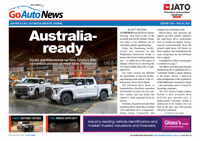Make / Model Search
News - HoldenHolden-made V6 turbo recalled in USKnocked up: The Cadillac SRX has been recalled to fix pre-detonating 2.8-litre turbo engines made by Holden. Dud fuel blamed for Holden engines blowing up in Cadillac SRX SUVs in North America28 May 2010 LOW-OCTANE fuel has been blamed for a number of failures of Holden-built turbo V6s powering luxury Cadillac SUVs in North America, triggering a vehicle safety recall in the United States. The 2.8-litre LP9 turbo engine – a 224kW high-performance variant of General Motors’ high-feature V6 that also powers the Holden Commodore and numerous other GM products – is built exclusively at the Port Melbourne plant in Australia for export to Cadillac, Saab and Opel. However, the finger of blame for the latest problem appears to be pointed at GM Powertrain engineers, not at the factory producing it. The turbo variant was largely engineered at Saab when it was a GM subsidiary. Working in tandem with their American powertrain counterparts in Pontiac, Michigan, these turbo engine specialists created the LP9 variant for vehicles such as the Saab 9-5 and forthcoming 9-4X SUV, GM Europe’s Opel Insignia OPC and Vauxhall Insignia VRX, and the Mexican-built Cadillac SRX. They appear not to have anticipated that some American Cadillac SRX drivers might fill their vehicles with low-octane 87 or 88 petrol, despite clear labels warning to use only premium fuel (rated as 91 in the US). In some cases, the poor fuel appears to have overwhelmed the anti-knock capability of the engine, causing catastrophic failure – the engine blows up.  From top: Cadillac 2.8-litre V6, Saab 9-4X and Opel Insignia OPC. From top: Cadillac 2.8-litre V6, Saab 9-4X and Opel Insignia OPC.The problem came to light when an American motoring journalist accidentally filled a test Cadillac SRX with the ‘regular’ 88 petrol, causing engine failure on California’s Highway 101. The stricken vehicle apparently was shipped back to GM’s Warren technical centre in Michigan where the engine was stripped by engineers for examination and the fuel was independently tested. GM concluded that a mixture of low-octane fuel and aggressive driving could induce severe pre-ignition, or pinging, to the point that pistons and/or conrods could be damaged, leading to engine failure in severe circumstances. Although GM says it could not replicate the failure on the road, bench testing of engines did. The fix is to recalibrate the anti-knock sensor to cope with the low-octane petrol. Because GM had reports of a number of other similar failures of cars in customer hands, it issued an official vehicle safety recall via the National Highway and Traffic Safety Administration (NHTSA) in Washington, asking owners to return Cadillac SRX 2.8-litre turbo vehicles to their dealer from June 11 to have the engine control module re-programmed. They have also been warned not to fill up with petrol lower than 91 octane, and not to drive their vehicle if the engine ‘pings’. As a sweetener, owners of affected vehicles are also being offered a 12-month free maintenance program for their trouble. A Holden spokesman told GoAuto that the issue was being handled by GM in the US. The LP9 engine apparently runs a high 9.5:1 compression ratio which, with turbocharging, requires premium unleaded fuel. In Europe, the engine has been used without apparent trouble in the Saab 9-3 Aero and the high-performance versions of the Opel/Vauxhall Insignia from early 2009, as octane levels are generally higher than those in the US – around 95RON minimum in many areas of the continent. The Saab 9-3 Aero turbo V6 was also sold in Australia by GM’s Premium Brands network before the sale of Saab to Spyker NV earlier this year, seemingly without ill affect on Australia’s petrol. The Cadillac SRX – built on GM’s Theta platform that also spawned the Holden Captiva and Chevrolet Equinox – went into production at GM’s Ramos Aripe plant in Mexico last year as a 2010 model. Offered with a choice of normally aspirated 3.0-litre direct-injection V6 – the same engine as offered in the 3.0-litre Holden Commodore – and 2.8-litre turbo V6, the SRX comes in front-wheel drive and all-wheel drive versions. A Saab variant, the 9-4X, will roll down the same Mexican production line later this year as a 2011 model, and will also feature the Holden-made 2.8-litre LP9 turbo V6, along with an alternative 2.0-litre four-cylinder turbo engine. Holden also exports V6 engines to South Korea, Thailand and China. As reported recently in GoAuto, exports of a Holden-made normally-aspirated high-performance V6 to Alfa Romeo are set to end, as the Italian company is switching to a new Pentastar V6 from Fiat Group partner Chrysler.  Read more |
Click to shareHolden articlesResearch Holden Motor industry news |










Facebook Twitter Instagram